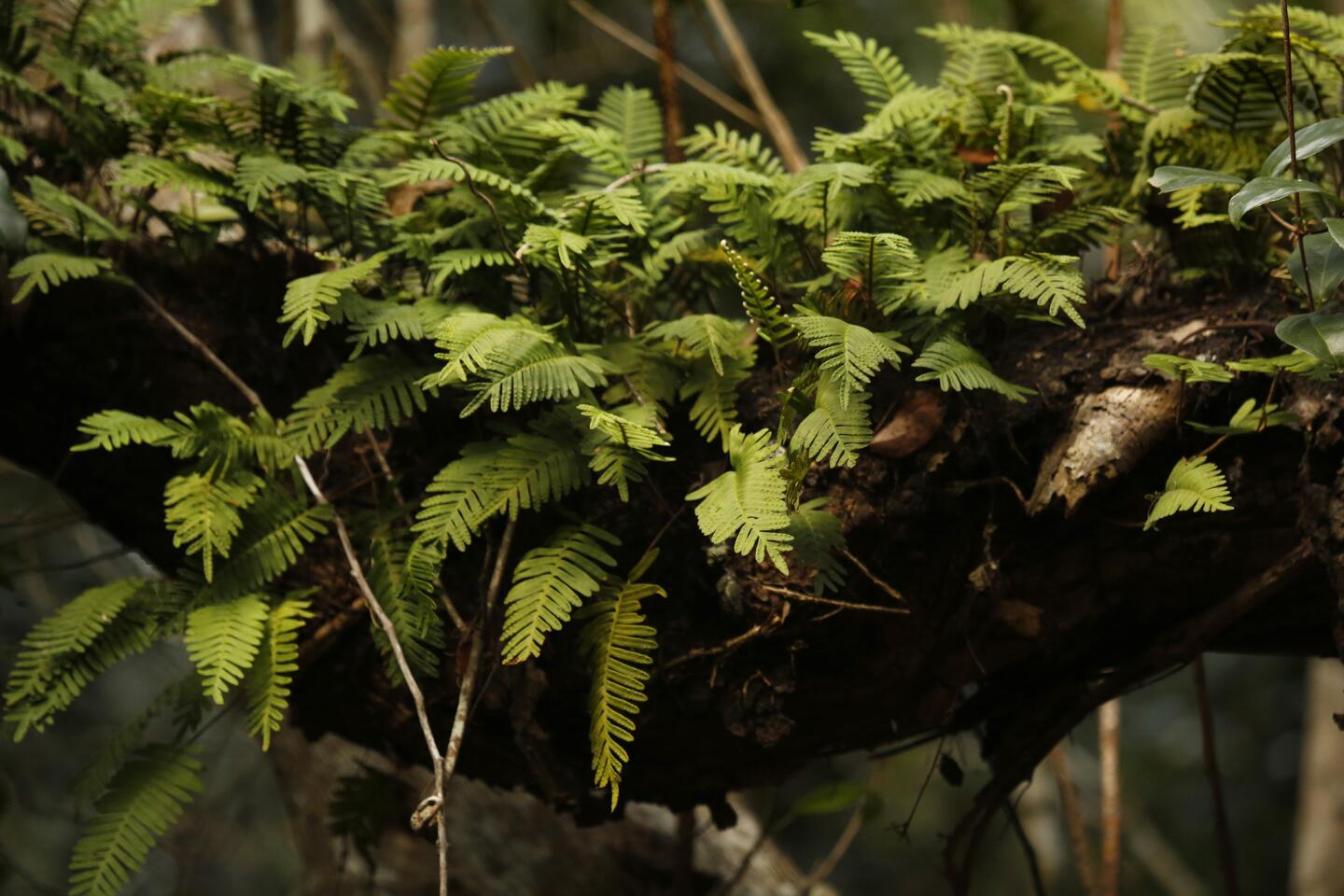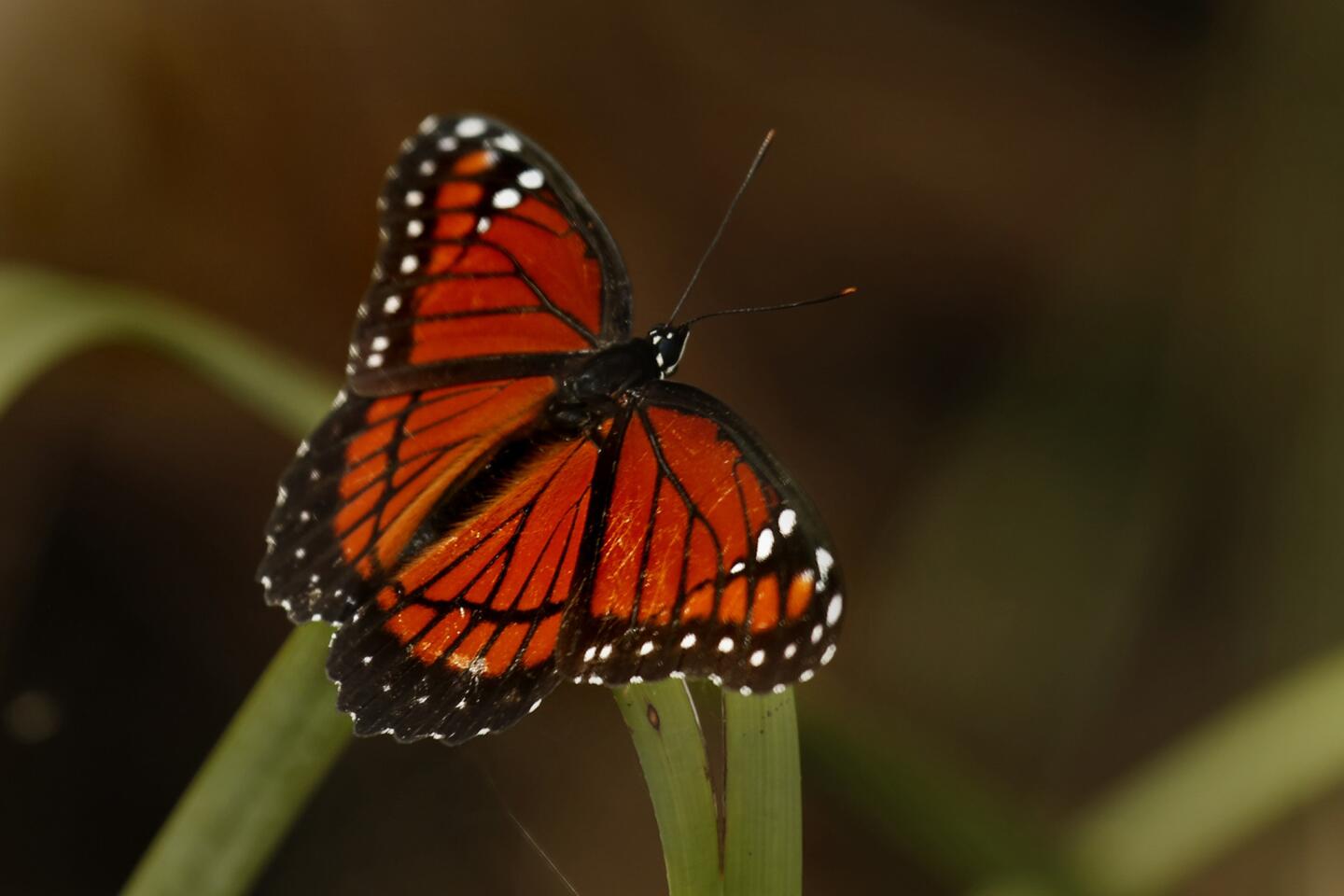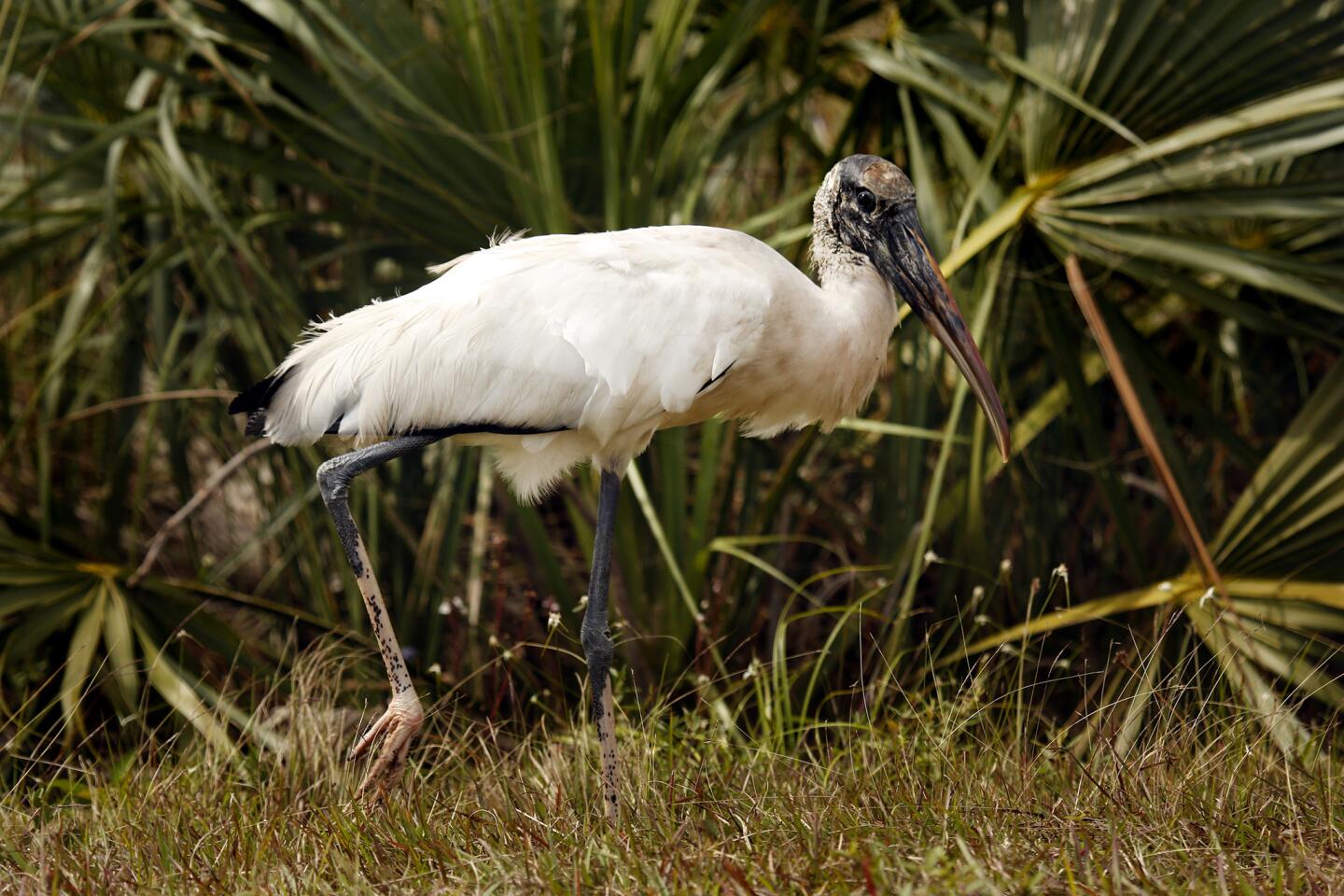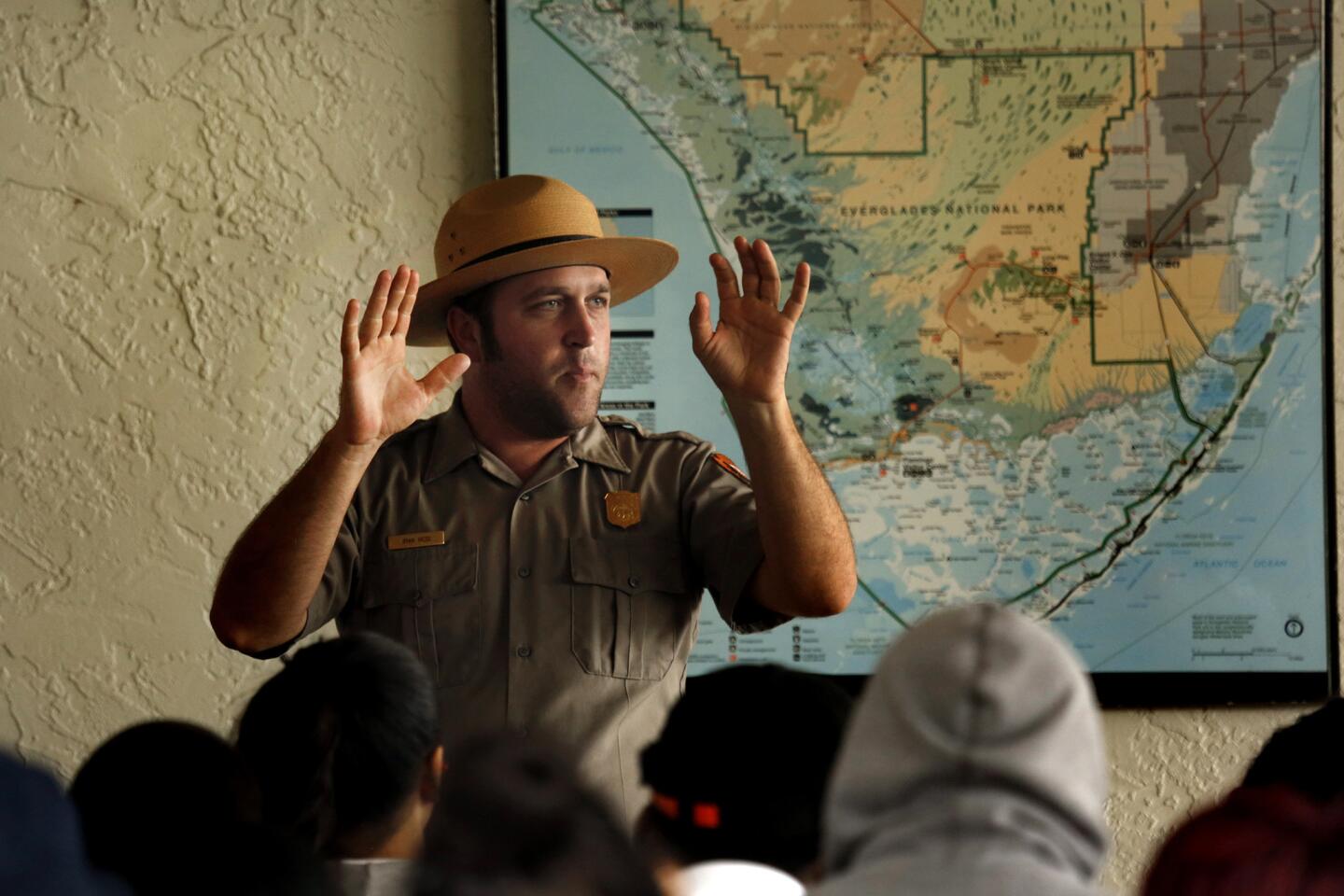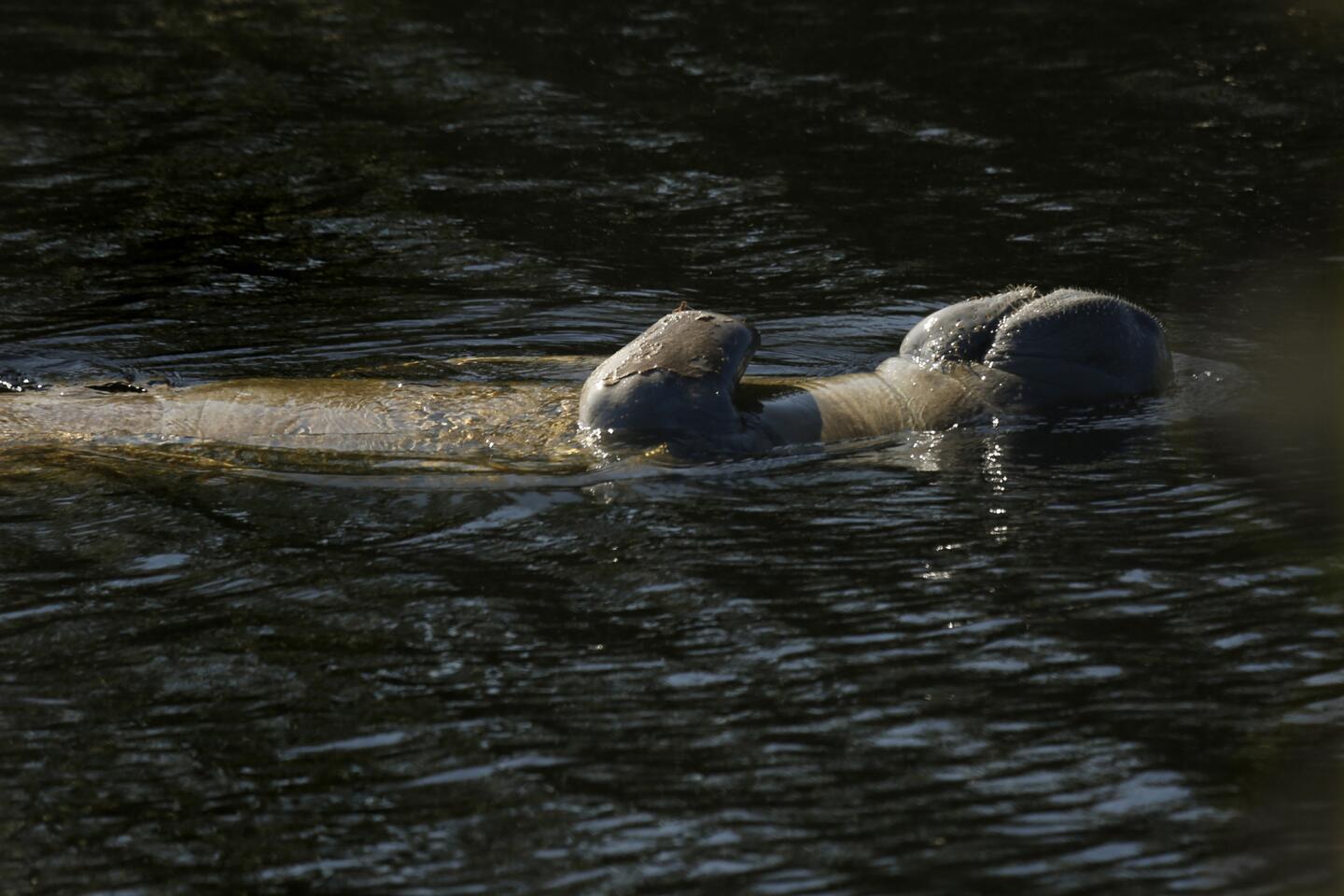You know about Florida’s alligators, but there’s so much more to see at Everglades National Park
- Share via
EVERGLADES NATIONAL PARK, Fla. — Spotting an alligator in Florida is a lot like spotting cattle in Texas. You don’t need to look very hard because they’re everywhere. There’s even a toll road nicknamed Alligator Alley where the 150-million-year-old reptiles can be seen lolling alongside the highway.
I didn’t realize how common they were until I visited Florida’s Everglades National Park, where I saw them hiding in grasslands, trolling for prey in ponds and snoozing in the sun on park trails.
It wasn’t always this way: The American alligator nearly disappeared from the landscape in the 1950s, the victim of hunters and the massive Florida housing boom that robbed them of their habitat. Fortunately, conservationists intervened, and the gator became an Endangered Species Act success story.
Read the series: Celebrating our national parks
Of course, this is what Everglades National Park is all about: conservation. It’s a story of life struggling to stay in balance, a place where people have affected the habitat and its residents and is now working to protect them.
The 1.5-million-acre park, third in size in the continental United States (after Death Valley and Yellowstone national parks), protects one of the most biodiverse areas in the world.
Its unique mix of tropical and temperate plants and animals includes more than 700 varieties of plants, 300 bird species and 27 kinds of snakes, as well as endangered species such as the manatee and panther.
Yet attacks by humans and nature threaten this giant ecological carnival.
That’s one of the reasons I visited recently: The survival of a host of animals hangs in the balance here, and I wanted to see as many of them as I could.
It didn’t take long. On my first morning in the park, I spotted a wood stork standing at the edge of a pond. The long-legged, 3-foot tall bird is the only member of the stork family that breeds in the U.S. Formerly on the endangered list, it was downgraded to threatened in 2014; it looks awkward on land but soars like a raptor in the air.
Less than an hour later, I saw an American crocodile sunning itself on a boat launch near the Flamingo Visitor Center at the far southern end of the park. The 1,000-pound creeper glared at me before sliding back into the sea.

Touring the Everglades.
No other wilderness area in the United States is quite like the Everglades; it doesn’t have lofty mountains, high glaciers or acres of conifers. Instead, visitors find a “River of Grass,” a name coined by early Native American inhabitants and conservationists to describe the wetlands that stretch more than 100 miles through the south-central part of the state.
That river makes it possible for crocs, gators and hundreds of other animals to exist. As a matter of fact, park rangers say, virtually every animal here is dependent on its water. That’s why Everglades National Park exists; it was the first park created to protect a threatened ecological system. Of all U.S. national parks, it alone holds three world designations: International Biosphere Reserve, World Heritage site and Wetlands of International Importance.

It’s also a surprisingly beautiful place encompassing the shallow, pale-blue waters and islands of Florida Bay, dense mangrove forests, towering palms, endless marshes and a savanna-like river of grass.
I started my wildlife safari in Miami, driving 40 miles south to the main park entrance (Ernest F. Coe Visitor Center and Park Headquarters) near Florida City. From there, a park road winds south to Flamingo at the edge of Florida Bay. Along the way, I found excellent overlooks and boardwalk-style trails that penetrated the swamps and marshes. In Flamingo, I hopped on a boat for a look at the marine and bird life.
Two other park entrances offer additional views of the park. The Shark Valley Visitor Center, at the north-central edge of the park, has a two-hour tram tour that explores one of the park’s major sloughs, with lots of opportunities to see birds and gators. At the northwestern-most edge of the park, check out the Gulf Coast Visitor Center in Everglades City, where you can catch a boat that will wind through the park’s Thousand Islands region.
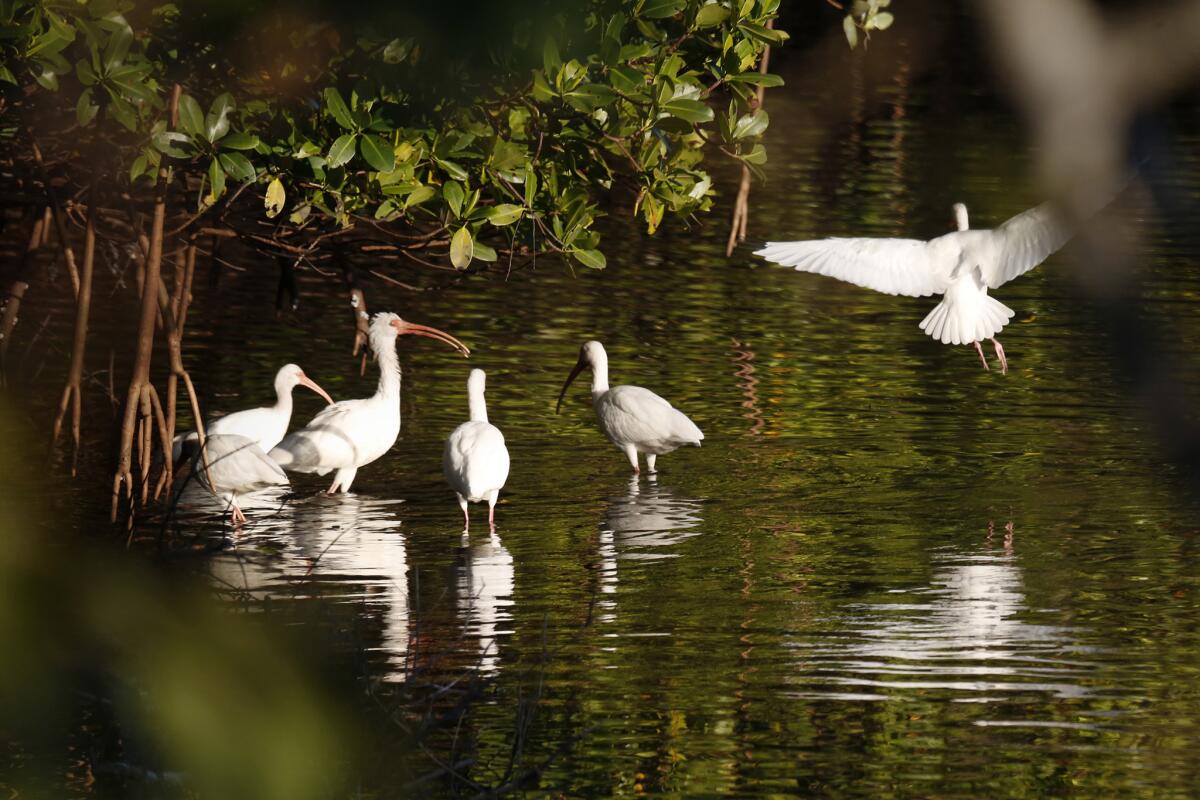
Our naturalist guide, Daniel Wilson, pointed out graceful great blue herons, white pelicans that stood 5 feet tall, and flocks of cormorants and terns. But the highlight came halfway through our two-hour trip.
“It’s show time, folks,” Wilson sang out. “Everyone on stage for the dolphin number.”
With that, a trio of Atlantic bottlenose dolphins skipped across the waves toward our boat, playing hide and seek in the wake as we sped through the blue waters of the Gulf of Mexico.
“Don’t I have the best job in the world?” Wilson asked. “I get to see this show every day.” No one argued.

Tips for visitors: How to get to Florida’s Everglades National Park, and where to stay and eat
How to get there
From LAX, American and Delta offer nonstop service to Miami International Airport, and American, United and Delta offer connecting service (change of planes). Restricted round-trip airfare from $278, including taxes and fees. The Miami airport provides access to Everglades National Park’s eastern gateway, near Homestead and Florida City, Fla. You can reach the park’s Gulf Coast entrance in Everglades City by way of Southwest Florida International Airport near Fort Myers or by U.S. 41, which skirts the park to the north.
Best time to visit
Winter is considered the dry season; there’s less rain and animals are easier to see because they congregate at watering holes. Also, temperatures are cooler, making a visit more pleasant. This year has been wetter than normal because of El Niño rains.
How to visit
Everglades National Park covers 1.5 million acres in South Florida so it can be a little daunting trying to figure out how to see it.
The main auto entrance is in Homestead’s Ernest F. Coe Visitor Center on the eastern side of the park, about 40 miles southwest of Miami. The Royal Palm Area is about a mile from the Homestead entrance and offers ranger-led walks, camping, canoeing and kayaking and more. The park service says this is the place to go if you have only one hour, and its Anhinga Trail is said to be outstanding for seeing wildlife especially wading birds.
From the main park road in this area, you can drive 38 miles to the Flamingo Visitor Center, the gateway to Florida Bay, which is at the southern end of the park and separates the mainland from the Florida Keys. Here you can canoe or kayak, and you’re apt to see a crocodile, given that you’re in salt water.
To see the northern part of the park from a different angle, travel west from Miami on U.S. 41, heading for Everglades City on the Gulf of Mexico side. It’s about 85 miles from Miami, but you can break up the drive about halfway by stopping at the Shark Valley Visitor Center. There, you can take a two-hour tram ride on a 15-mile trail or rent bicycles.
At Everglades City, the Gulf Coast Visitor Center is the main access to Ten Thousand Islands, accessible by boat tour or canoe. The shallows teem with marine wildlife, especially babies.
Accessibility
Besides accessible visitor centers, the park has many paved trails, several of which are less than a mile long. Anhinga Trail at Royal Palm Visitor Center is a good place to see alligators and wildlife; at Pahayokee Overlook you can see miles of saw grass and cypress tree islands from an accessible ramp.
Know yourself
Watch for poisonous snakes and for Burmese pythons, which can be very dangerous. Also, an alligator sleeping in the sun on a trail may seem tame, but it’s not. Keep your distance.
What to wear
The sun can be brutal year-round; wear cool clothes, sunscreen and a hat. Long-sleeve shirts and long pants, plus mosquito repellent, will help you avoid Florida’s notorious skeeters.
Sleep
Ivey House, 107 Camellia St., Everglades City, Fla.; (239) 695-3299, www.iveyhouse.com. Small, well-kept bed-and-breakfast and lodge near the Gulf Coast entrance to the park. Some rooms have shared bath; most are en-suite. Pool, excursions available.
Eat
Havana Cafe Restaurant, 191 Smallwood Drive, Chokoloskee, Fla.; (239) 695-2214, www.myhavanacafe.com. Three miles south of Everglades City. Open-air patio and indoor seating at this lively cafe specializing in Cuban cuisine, soft-shell crab and key lime pie. Open October-April.
More info
Everglades National Park, (305) 242-7700, www.nps.gov/ever
MORE NATIONAL PARKS
Series: Celebrating our national parks
Our favorite stories from national parks of the west
National Parks celebrates 100 years: Readers share their memories
Sign up for The Wild
We’ll help you find the best places to hike, bike and run, as well as the perfect silent spots for meditation and yoga.
You may occasionally receive promotional content from the Los Angeles Times.


